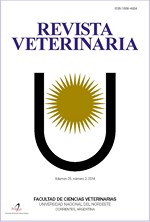Lipid peroxidation assays in canine fresh semen
DOI:
https://doi.org/10.30972/vet.2021857Palabras clave:
dog, spermatozoa, lipid peroxidation, polyunsaturated fatty acids.Resumen
Lipid peroxidation (LP) is a potential cause of infertility in males of numerous species. Levels in which the spermatozoa loses mobility in vitro is correlated with the rate of LP that it suffers. The objective of this work was to determine the fatty acid composition and analyze the sensitivity to LP (ascorbate–Fe++ dependent) in spermatozoa obtained from different samples of canine fresh semen. LP was evaluated using chemiluminescence (CL) (cpm/mg of protein) and fatty acid (FA) profile by means of gas chromatography. The saturated FA content found in the analyzed spermatozoa was approximately 40%, whereas the total unsaturated FA content was approximately 55% with a prevalence of docosapentaenoic acid (C22:5 n6). When the control and ascorbate–Fe++ dependent samples were compared, it was observed a significant increase in the light emission (CL). Consequently, significant decrease in the percentage of the polyunsaturated fatty acids (PUFA) was obtained, being more affected: C18: 2 n6, C20: 4 n6, C22: 4 n6, C22: 5 n6 and C22: 6 n3. The unsaturation index used to evaluate the alterations generated during the LP was correlated with the data mentioned before. Our results indicate that dog semen contains great amounts of PUFA, which were vulnerable to the LP. The alteration in the PUFA composition could be the common base of different degenerative processes.
Descargas
Descargas
Publicado
Cómo citar
Número
Sección
Licencia
Derechos de autor 2009 M. Gavazza, A. M. Gutiérrez, M. Marmunti, A. Palacios

Esta obra está bajo una licencia internacional Creative Commons Atribución-NoComercial 4.0.
Política de acceso abierto
Esta revista proporciona un acceso abierto inmediato a su contenido, basado en el principio de que ofrecer al público un acceso libre a las investigaciones ayuda a un mayor intercambio global de conocimiento. La publicación por parte de terceros será autorizada por Revista Veterinaria toda vez que se la reconozca debidamente y en forma explícita como lugar de publicación del original.
Esta obra está bajo una licencia de Creative Commons Reconocimiento-NoComercial 4.0 Internacional (CC BY-NC 4.0)










.jpg)
.jpg)



